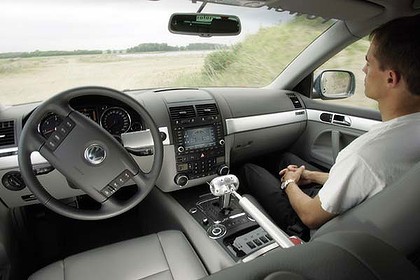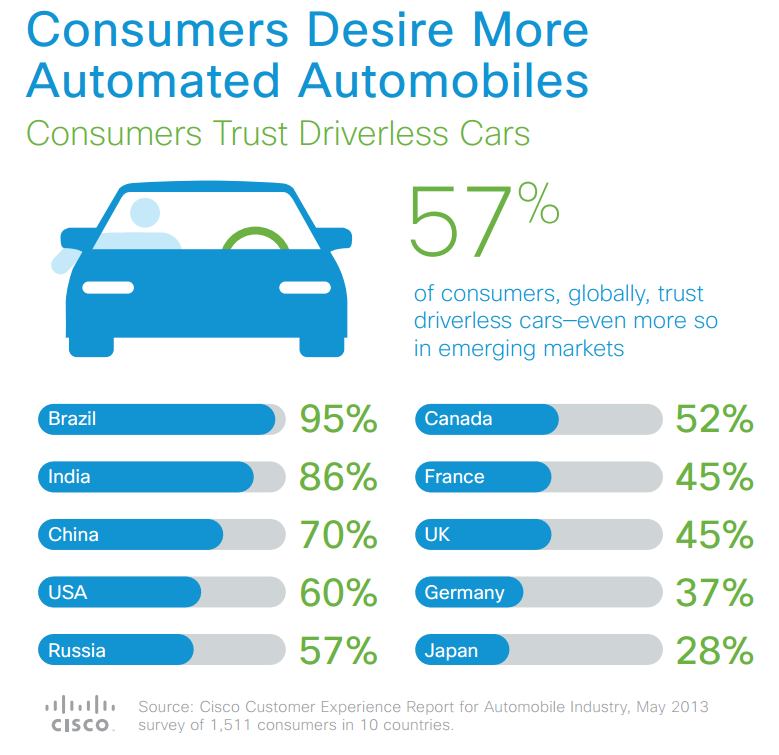As auto makers gear up to offer technology that automates the most grinding parts of a daily drive, getting customers on board could be the easy part. It is the regulators and insurance companies that may need the hard sell.
Between now and 2016, an increasing number of car makers will offer “traffic jam assist” systems that take over braking, steering and acceleration for vehicles inching along in low-speed traffic. It is a far cry from Google Inc.’s vision for a car that can drive itself in all conditions, but auto makers and suppliers have long taken the view that quantum leaps typically take place one mile at a time.
Auto industry executives say they intend to offer systems that can robotically pilot a car at speeds up to 40 miles per hour within about five years. Meanwhile, federal safety regulators say they are still conducting research on the potential safety and benefits of autonomous technology.
Automated parallel parking systems are legal for use, but that technology is more about convenience than preventing collisions. Advocates say full-blown use of self-driving technology will sharply reduce the 90% of accidents that are based on driver error.
Regulators and insurance companies are unprepared, however, to welcome even incremental steps that allow hands-free driving—a reality that could blunt demand for even limited self-driving technology.
“Why buy an autonomous vehicle if you have to maintain control?” asks Adrian Lund, president of the Insurance Institute for Highway Safety, who predicts hands-free driving systems won’t be offered soon because of legal and insurance barriers. While some states allow professional drivers to experiment with autonomous controls, not one has issued a plan that allows everyday road warriors take their hands off the wheel for significant periods.
U.S. auto-safety regulators are “spending a lot of our time on early warnings systems because we feel these technologies can bring down the accident numbers,” Nat Beuse, associate administrator at the U.S. Department of Transportation, said at an industry conference on Monday.) However, the National Highway Traffic Safety Administration hasn’t proposed rules that would allow hands-free driving, and has advised states not to allow operation of autonomous vehicles on public roads except for testing by professional drivers.
Volkswagen is one of the car companies prodding lawmakers to speed up work on rules to govern a world of self-driving cars. The German auto giant’s Audi division has begun using Tampa’s Lee Roy Selmon Expressway to test a higher-speed traffic jam pilot system installed on an A7 sedan bearing a Florida plate that reads “Self1e.”
The “Self1e” A7’s system can automatically keep pace with the vehicle ahead, stop itself, speed up and stay in its lane without the driver’s help. In fact, touching the steering wheel or hitting the brake turns off the autonomous system, which could operate up to 40 miles an hour. As of now, however, this level of hands-free driving isn’t legal.
Florida Gov. Rick Scott was among those in line for a recent test drive of the A7. Mr. Scott said he has “a good legislature I can work with” when the technology is ready. State Sen. Jeff Brandes, who pushed the law allowing Audi to test on state roads, says he needs to see more testing occur before drafting laws allowing ordinary motorists to drive hands-free.
Industry players looking for a more immediate ray of hope are turning their gaze to California. Bernard Soriano, California’s Department of Motor Vehicles deputy director, said the agency could publish draft regulations on the issue this month. The agency hopes to have final rules in place by January. California—home to autonomous driving pioneer Google—is one of four states to allow professionals to test self-driving cars on public roads.
Mr. Soriano says draft rules would address issues such as who would be responsible for a car driving on autopilot, (Likely answer: Whoever put the car in motion either from inside the vehicle or from a remote location.) The rules also would outline certain technical specifications, such as requiring that event data recorders aboard a self-driving car be capable of retaining 30 seconds of data before a crash.
A regulatory road map, however, won’t solve everything. Insurers say they would need to see lower costs reflected in real-world experiences before making coverage decisions. “We don’t use our intuition,” says Dick Luedke, a spokesman for State Farm Mutual Automobile Insurance Co., the No. 1 U.S. auto insurer. “We use the data.”
Clarity on regulations could help companies and consumers as more autonomous features hit the road. Nissan Motor Co. will start launching automated driving and parking systems on a wide range of vehicles in 2016, and expects to put into production a system that would allow a car to automatically change lanes to avoid a hazard by 2018.
Daimler already is chipping away at the question of customer demand. Its new Mercedes-Benz S-class sedan offers a $2,800 “driver assistance” package that includes automatic braking and an advanced cruise control and a “steering assist” system that can keep the car centered in a lane and automatically adjust speed based on the behavior of vehicles ahead. The technology could pilot a car in rush hour traffic with minimal driver intervention, but it shuts off if the driver’s hands leave the wheel for more than a few seconds.
More than 85% of S-class buyers order the option on a car already costing between $94,400 and $141,450. Mercedes plans to spread the technology to other, less expensive models, including the E-Class and the redesigned 2015 C-Class which launches this fall, at a likely starting price under $40,000.
Engineers are emboldened by the rate of innovation taking place in self-driving technology, a trend that could cut costs and boost availability. For instance, Audi of America Director of Product Management Filip Brabec said the electronic hardware needed to allow hands-free operation of the A7 shrunk in one year from a trunkload of gear to a module the size of a laptop.
Maryanna Saenko, an analyst with Lux Research in Boston says external skepticism of self-driving technology has merit. Among the concerns: the high cost of laser vision, the risk that radar and camera sensors won’t see properly in bad weather, and complex legal issues raised by giving control to a robot, she says.
It is unclear if any auto maker, or tech industry players like Google, can soon answer all the questions posed by self-driving cars, some of which veer into the realm of philosophy and ethics. Ms. Saenko says one sticking point is a debate over whether automated driving systems should be programmed to hit a larger sport-utility vehicle or a potentially more vulnerable small car in a case where a crash is unavoidable.
These questions won’t be resolved solely by engineers or safety experts. California lawmakers wrote into the statute allowing on-road testing of autonomous cars a requirement that the legislature will get 180 days to review any application to offer a fully autonomous car before a manufacturer can sell it to consumers.








